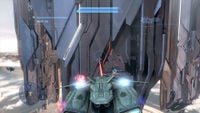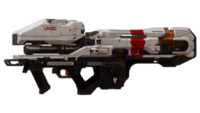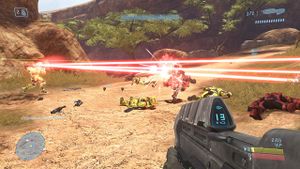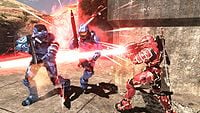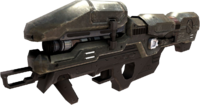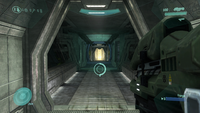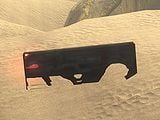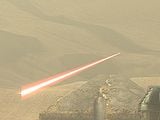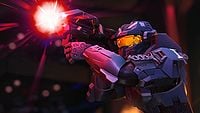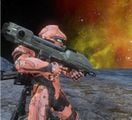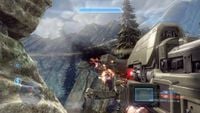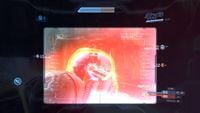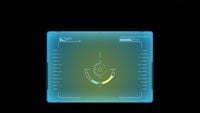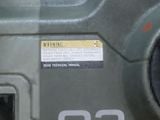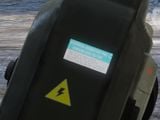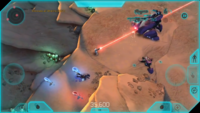M6 Spartan Laser
From Halopedia, the Halo wiki
The Weapon/Anti-Vehicle Model 6 Grindell/Galilean Nonlinear Rifle (M6 G/GNR), colloquially known as the Spartan Laser, is a man-portable and vehicle-mounted solid-state[1] directed-energy anti-vehicle weapon used by the United Nations Space Command.[2][3] It is one of the only known directed energy weapons fielded by UNSC forces, aside from the pulse lasers used by Office of Naval Intelligence prowlers and the X23 NNEMP Cannon used by Gremlin Combat Support Vehicles.
Background
Originally created to work with the GUNGNIR MJOLNIR Armor, the M6 G/GNR was developed as part of Project GUNGNIR, a program designed to provide supplementary matériel for the SPARTAN-II program, hence the "SPARTAN Laser" moniker.[4][5] The M6 G/GNR is a man-portable, shoulder-fired, directed energy weapon used by the UNSC. When the trigger is pulled, a red targeting laser is painted on-target accompanied by an audible whine as the weapon cycles up. The Spartan Laser will then charge for approximately three seconds before discharging the main laser. As the Spartan Laser charges, the charging tone gets noticeably louder and increases in pitch up until the laser is fired. The firing sequence can be aborted without discharging the battery as long as the weapon is not actually fired; for example, if the target moves out of sight or the operator needs to displace. The laser is a powerful microsecond-long pulse of energy capable of burning through thick plates of metallic laminates, nanocomposites, or hardened steel. The casing holds a high-capacity battery cell that feeds into a pulsed-power array and crystal slabs that produce the weapon’s devastating beam.[1] Heat management forces significant downtime between shots, and so the weapon enters an approximately two-second-long standby sequence between shots.[6] The Spartan Laser has a small blast radius, injuring targets within two meters of the point of impact and toppling light vehicles.
The Spartan Laser is the most expensive small arm known to be produced by the UNSC. It costs 218,000.00 cR, more than the cost of four fully armed M12 Warthogs, 134 MA5B assault rifles, or over 7,266 M9 fragmentation grenades. Although the Spartan Laser was considered to be "ruinously expensive" at the time of its introduction, later refinements led to a reduction in production cost which is now only considered to be "extraordinarily expensive". During the Human-Covenant War, only Orbital Drop Shock Troopers and Spartans were given ready access to the weapon.[1]
Variants
The AV-22 Sparrowhawk is equipped with a nose-mounted M6 G/GNR in addition to its twin-linked autocannons.[7] This version of the Spartan Laser has similar firing and recharge rates to the man-portable version, though it has higher damage potential. Unlike the standard Spartan Laser, however, the version mounted on the AV-22 fires a bluish-white beam, which may suggest higher intensity; this is likely, as the Sparrowhawk can certainly carry a more powerful battery than the BA-53635/PLMD used by the standard version.
M6/E
The E ("Enhanced") model M6 high-energy laser is just as capable as earlier examples, but is an order of magnitude cheaper to manufacture. Primarily used as an anti-tank laser, the M6/E fires a devastating energy pulse after a short warmup time.[8]
Endgame
Endgame is an improved model of the M6/E variant with more battery capacity and reduced charge time. It has the downside of having less power.
Selene's Lance
This variant of the M6E model is built using new components from the labs in Seongnam. It has a faster charge time, and a longer beam duration, with additional battery capacity. The targeting laser is also harmful.
In War Games simulations balancing adds extra recoil to Selene's Lance.
M8C G/GNC
The M8C Grindell/Galilean Nonlinear Cannon[9] is a nose-mounted variant that is equipped on the G79H-TC Pelican gunship. It functions similarly to its infantry-carried counterpart, but on a much larger scale. Due to the increase in size, its damage output is increased as well, allowing it to obliterate large vehicles such a Phantom with only a few direct hits. The M8C also has an effectively unlimited supply of ammunition as it draws power from the gunship it is mounted on rather than a battery.
Operation
Targeting
When the weapon is equipped, a shroud over the emitting lens of the laser lifts up to expose it, presumably to protect it from scratches and battle damage when holstered, although the weapon is shown with the shroud up when it is on a person's back. This was probably an overlooked graphics flaw in the games, though. The shroud can be seen releasing from its protective state when the weapon is drawn in first person view. A small hydraulic or pneumatic cylinder on the left side of the shroud actuates the shroud where it is anchored to the chassis of the weapon. When the trigger is pulled, a harmless red laser sight is projected on the target and a unique targeting tone is emitted which slowly becomes louder. The Spartan Laser will then charge for four seconds[10] before firing a red laser beam that usually destroys the target. In the Halo 3 beta, if the reticule was moved while firing, a scattering of beams would be released, spreading over the targeted area. For the few frames while the laser is fired, the right targeting stick is disabled. The beam can be strafed, however, over a larger area if the player is moving while the laser is firing.
The Spartan Laser is equipped with a smart-linked Wyrd III optics suite for increased accuracy and is capable of 3x magnification. Its reticule, whether on 1x or 3x magnifications, features a meter on the right side showing the charging status of the laser. The tick mark rests at the bottom of the circular shaped reticule while the laser is dormant, and gradually travels along the reticule's circumference until it reaches the point of origin, indicating that the laser is currently discharging.
Laser beam
Contrary to popular belief, the Spartan Laser is not a one-hit, one-kill weapon. In gameplay, damage is inflicted on a target by means of multiple, precision strikes from the laser. Instead of what appears to be one intense, uninterrupted beam of energy, the laser is actually multiple, but smaller, charges of energy, sent downrange in rapid succession, giving the appearance of a continuous beam. As the laser is light, there is little chance for escape or evasion before imminent doom. However, it is possible to avoid complete annihilation by traveling at high speeds or quickly finding some cover, thus avoiding the rest of the devastating beam, which allows for targets to be "clipped" but survive. Once the main laser is discharged downrange, the target receives the intense increase in energy as thermal energy, which then proceeds to impart physical changes upon the target. With each passing millisecond the target is hit by the main laser, the energy levels rise until they become intolerable and result in combustion, in the case of vehicles, or death.
Under normal circumstances, as long as a direct impact is delivered, one laser shot will destroy any target. Wraiths cannot simply be fired upon at any location; each has a vulnerable point that must be hit in order to achieve a catastrophic kill with one shot. The Wraith must be fired upon from the vehicle's rear, right below the mortar at its power core, or directly aimed at the cockpit. The Scorpion must be hit in the driver's canopy to kill him or her instantly, though to destroy the tank you must aim for the exhaust vent. It is powerful enough to make its way through nine Warthogs parked bumper to bumper. It is also highly effective at destroying Scarabs' leg joints, although The Covenant is the only mission where this can be done, and it is unlikely the player will keep the Spartan Laser that long into the level without completely draining its battery.
The intense energy of the beam imparts splash damage up to a range of approximately two meters from the impact point. A careless operator that discharges the laser while too close to any obstacle will instantly be killed. The beam can also penetrate multiple obstacles and/or targets, provided they are aligned along a linear trajectory.
It is powered by a BA-53635/PLMD non-replaceable battery, which is recharged with a PP-16979/AM-Sh charger. UNSC logistics, however, are not sufficient for the charger to accompany many M6 G/GNR units in the field.
The version of the M6 G/GNR mounted on the AV-22 Sparrowhawk fires a bluish-white beam. The color of the beam suggests that it is fired at a higher intensity than the man-portable version, which is likely, as the mounted version has greater firepower due to the connection to the Sparrowhawk's main power supply.
Gameplay
- "It's not overpowered. It's an elegant weapon from a more civilized age."
- — Luke Smith
Advantages
The Spartan Laser, commonly known in player lexicon as the Splaser, is the most powerful small arm in Halo 3, Halo 3: ODST, and Halo: Reach, combining long range with lethal force. Most destructible vehicles are often destroyed in a single blast, except in the case of a near miss, in which case the target will still suffer heavy damage. It can also easily strike and kill multiple opponents and vehicles if they are lined up correctly. In Halo 4, its destructive capabilites are only matched by the Incineration Cannon, which is far less accurate than the Laser.
Disadvantages
As with all powerful weapons, there are a few disadvantages. The Spartan Laser needs to charge for three seconds, (four seconds after Title Update 2), before firing, and requires another two to four seconds to cool down after firing. In Halo 3 and Halo 3: ODST laser uses 20% of its battery's charge per shot, giving only five shots at most. In Halo: Reach and Halo 4, the weapon uses 25% of its battery power per shot, allowing a maximum of four shots.
The targeting laser may give away the operator's position. If a player sees the targeting beam, they could possibly dodge the shot, thus wasting valuable battery power, though this is very unlikely, as the targeting beam is very faint and hard to see in the midst of battle, and at long distances. However, it is possible to hear the laser if you are near the operator, and can thus enact a countermeasure to prevent the operator from striking. A point blank shot can cause fatal splash damage to the wielder, and close-range combat with the weapon puts them at risk of being injured or killed by debris.
The Laser's cycle time is dangerously long; while venting, the user is vulnerable to counter attack.
Finally, the laser is infamous for the difficulty in aiming the weapon, being nearly impossible for inexperienced players to engage quick, erratically-moving targets (such as infantry units). This is caused by the charging time, which mandates that the player keep a manual, accurate lock on his or her opponent, lest the laser discharge in vain. Should the target duck behind cover or out of line of sight and the operator cancel the firing sequence, it starts from the beginning.
Halo 3 and Halo 3: ODST
The weapon is not available in the Halo 3 campaign until the level The Covenant, in which John-117 begins the level armed with the Spartan Laser. There is another Spartan Laser lying nearby on the ground near the Pelican, presumably dropped by a Marine when it was shot down. The M6 is the only weapon able to harm 343 Guilty Spark on the final level of Halo 3, with the exception of the Fuel Rod Gun and Rocket Launcher, through a glitch.
In Halo 3 Multiplayer, killing another player with the Spartan Laser awards the Laser Kill Medal. The achievement "Two for One" is unlocked by scoring a double kill with a single laser shot in any ranked free-for-all playlist.
In Halo 3: ODST, the weapon appears in the levels Uplift Reserve, Kizingo Boulevard, ONI Alpha Site, NMPD HQ, and Coastal Highway, usually in hands of Dutch, as well as in all Firefight maps. The weapon charges slightly faster than in Halo 3.
Halo Wars
- In the campaign, Jerome-092 and two of the members of Team Omega are armed with Spartan Lasers.
- In skirmish and multiplayer, the Spartan Laser is the final upgrade available to SPARTANs.
- The Sparrowhawk is equipped with a chin-mounted Spartan Laser.[7]
Halo Reach
In campaign, multiplayer, or Firefight, getting 5, 10, and 15 kills with the Spartan Laser without dying will award (respectivly) the "Laser Spree", "Red Menace", and "Sunburst" medals to the player. Like in Halo 3, killing an enemy with the weapon will give the player a Laser Kill Medal and one point towards the "Heavy Weapons" Commendation (or the equivilent, depending on the game mode)
Halo 4
The spree medals are not present in Halo 4 multiplayer, though the "Laser Kill" medal remains, and gaining a kill with the weapon will award a single point towards the "Spartan Laser" commendation.
Changes from Halo 3 and Halo 3: ODST to Halo: Reach
- The Spartan Laser has a slightly altered form factor, a darker color scheme, a different charging animation, and a thermal display attached to the side, which folds out when the weapon is unholstered or picked up. The weapon depletes a quarter of the battery's charge per shot, meaning it only has four shots, decreased from five in Halo 3 and Halo 3: ODST .
- The Spartan Laser has a longer forward grip, with less space between it and the trigger than in Halo 3, making it appear that there is not enough space for the forward grip to fold up when not in use.
- When the weapon is charged, instead of one arrow moving down on the side of the reticule, two arrows move toward each other, meeting at the side of the reticule.
- The charging time is now 2.5 seconds exactly.
- The scope no longer zooms out instantly after each shot.
- The beam can now be moved in a sweeping motion (albeit for a brief time), inflicting (reduced) damage to multiple targets.
Changes from Halo: Reach to Halo 4
- The weapon has been given new sound effects.
- The weapon now lacks the rear metal bar that is present on the Halo: Reach version.

|
See our gameplay information related to M6 Spartan Laser on its gameplay page. |

|
Browse more images in this article's gallery page. |
Trivia
- As a reference to its development program, the side of the weapon has the Norse symbol for Gungnir etched into it, which was the mythical spear wielded by the god Odin in Norse Mythology. Gungnir was described as having the ability to always hit its mark. Part of the mythology is that Odin would hurl his spear over the doomed side of a battle. The word "Galilean" is also printed on the side of the weapon.
- The Spartan Laser's beam seems to trail off forever when fired into the sky, very much like the Sentinel beam. The beam of both weapons does end, however, usually at the invisible walls of the playing area. The laser beam on Sandtrap covers over 75% of the width of the area when fired at a 45-degree angle.
- It remains unclear what kind of mechanism the M6 uses to create its laser beam. Some have suggested that it uses a chemical laser; however, a gas or chemical laser does not produce a powerful energy output, and also require large amounts of highly volatile and toxic chemicals to function, which are expended as the weapon fires. The weapon seems to be only powered by a rechargeable battery pack, hinting that it may be a Solid-State Laser or Free Electron Laser, which does not require a constant source of a chemical gain medium.
- Luke Smith's comment: "It's not overpowered, it's an elegant weapon from a more civilized age," is a reference to Star Wars' lightsabers, described as such by Obi-Wan Kenobi.
- In The Package, the Spartan Laser is shown to be able to deflect an energy sword and is, in that instance, dual wielded with an SMG.
- In The Package, after Frederic-104 fires his Spartan Laser twice, his HUD shows its battery has 80% of its power left, meaning his Spartan Laser has only expended 10% of its power with each shot. However, in Halo 3, Halo 3: ODST and Halo: Reach as well as Halo 4, the Spartan Laser uses 20% and 25% of its battery with each shot respectively. It is possible the Spartan Laser can change the amount of battery charge used in its shots, as the shots fired by Frederic seem dramatically weaker than those fired in the games.
- When the player picks up a Spartan Laser that has a battery percentage that does not divide by 20 evenly, he will be able to fire a 20% powered laser and another shot after that with the remaining charge.
- As with all battery weapons, a weapon with low power that is dropped on the ground when its AI operator is killed will be assigned a random power level between 60% and 70%, unless you have the famine skull on.
- Oddly, the Spartan Laser's barrel cover can be seen opening up when the player switches to it, even though it is already open on the player's back.
- Early concept art of the Halo: Reach starfighter YSS-1000 Sabre includes the Spartan Laser, which was most likely replaced by the Medusa missiles.
- Unlike other weapons, an emptied M6 G/GNR will never appear on the ground when dropped.
- The Halo 4 model of the Spartan Laser has an electric shock warning of 1.21 gigawatts, in reference to the DeLorean time machine from the Back to the Future series. The laser aperture warning decals say, "Big Scary Laser: Do not look into beam with remaining eye."
Gallery
Normal Gallery
Concept art of the M6 Spartan Laser before the Halo 3 Beta.
A 2D Spartan Laser uncovered through modding.
The end of the laser beam across Sandtrap.
A Sparrowhawk fires its nose-mounted Spartan Laser. Note the blueish beam, instead of the normal red laser.
Frederic-104 firing a Spartan Laser in The Package.
- Reach M6 G-GNR.jpg
Concept art of the M6 G/GNR for Halo: Reach.
- H4-Concept-M6SpartanLaser.jpg
Concept art of the M6 Spartan Laser in Halo 4.
Spartan Sarah Palmer using the M6 G/GNR against a Type-26 Wraith in Halo: Spartan Assault.
- H5G-SplazerHUD.png
First-person view of the M6E Spartan Laser in Halo 5: Guardians.
- H5G-Splazerzoom.png
Smart scope with the M6E Spartan Laser on Escape from ARC.
- H5G-SelenesLance-FP.png
First-person view of Selene's Lance in Halo 5: Guardians.
Halo 5: Guardians REQ Cards
List of appearances
- Believe
- Diorama (First appearance) (Diorama only)
- Halo 3
- Halo Wars
- Halo: Helljumper
- Halo 3: ODST
- Halo Legends
- Halo: Blood Line
- Halo: Reach
- Halo: Fall of Reach
- Halo 4
- Halo: Spartan Assault
- Halo: Spartan Strike
- Halo: Last Light (Mentioned only)
- Halo 5: Guardians
- Halo Online
Sources
- ^ a b c Halo Waypoint: Spartan Laser
- ^ Cite error: Invalid
<ref>tag; no text was provided for refs namedBungie - ^ Halo Encyclopedia, page 315
- ^ Halo Waypoint: MJOLNIR 2
- ^ Halo: Reach, GUNGNIR Armory description
- ^ halo3.com
- ^ a b Halo Wars: Limited Edition, Professor Anders' leader card
- ^ Halo Waypoint - Cannon Fodder: Locke & Load
- ^ Halo 4: The Essential Visual Guide, page 113
- ^ http://www.1up.com/do/previewPage?cId=3155479
| |||||||||||||||||||||||||

